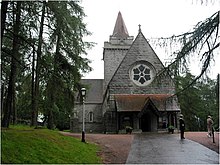Crathie Church
| Crathie Kirk | |
|---|---|

Crathie Kirk
|
|
| 57°02′23″N 3°12′44″W / 57.0397°N 3.2123°WCoordinates: 57°02′23″N 3°12′44″W / 57.0397°N 3.2123°W | |
| Denomination | Church of Scotland |
| Churchmanship | Reformed |
| Website | braemarandcrathieparish |
| Administration | |
| Presbytery | Kincardine & Deeside |
| Clergy | |
| Minister(s) | Revd Kenneth Mackenzie |
Crathie Kirk is a small Church of Scotland parish church in the Scottish village of Crathie, best known for being the regular place of worship of the British Royal Family when they are holidaying at nearby Balmoral Castle.
Crathie Kirk is now united with neighbouring Braemar to form a single parish with two places of worship. Eventually this parish will be further enlarged to include Glenmuick (Ballater). The minister (since 2005) is the Reverend Kenneth Mackenzie. Mackenzie was previously minister of the Church of Scotland congregation in Budapest, Hungary (1999–2005).
Crathie has been a place of Christian worship since the 9th century when a church was founded on the banks of the River Dee by Saint Manire (Bishop of Aberdeenshire and Banff and a follower of Saint Columba, the pioneer of Christianity in Scotland). It is traditionally held that Manire baptised Pictish converts in a pool of the Dee east of the modern village of Crathie. A single standing stone at Rinabaich is all that remains of Manire's church (where Manire himself is reputedly buried). Subsequent places of worship were situated further west, near the location of present-day Crathie village. The ruins of a 13th-century church, dedicated to Saint Manire, stand on the riverbank south of the current structure.
A later church was built at the current site in 1804. Queen Victoria worshipped there from 1848, and every British monarch since has worshipped at Crathie Kirk. Victoria laid the foundation stone for a new, much larger, church in 1893. Victoria's decision to worship at Carthie Kirk initially caused a scandal, particularly when it was discovered that she had received communion there. As Supreme Governor of the Anglican Church of England, it was expected that she would worship in the Scottish Episcopal Church, which recognised the authority of the Archbishop of Canterbury.
...
Wikipedia

